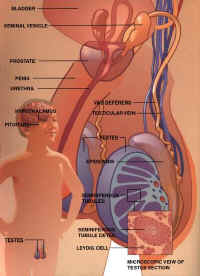Testes
 The testes are the male sex glands. The glands are located in the scrotum, a sac of skin between the upper thighs.
The testes are the male sex glands. The glands are located in the scrotum, a sac of skin between the upper thighs.
At puberty, the pituitary signals the testes to produce the hormone that controls the development of male secondary sex characteristics – growth of the testes and penis, hair on the face and body, a deeper male voice, and broader shoulders.
When things go wrong
Low hormone levels can result in delayed puberty. In boys, delayed puberty means the first sign of physical change, enlargement of the testes, has not occurred by age 14. Tests may determine if there is a problem with the hypothalamus or pituitary gland, or with the testes.
Klinefelter syndrome is a disorder that is due to boys having two or more X chromosomes. Boys tend to be underweight and tall for their age, with particularly long arms and legs . Breast enlargement, a condition called gynecomastia, is common.
Precocious puberty in boys is noted by enlargement of the testes, and body hair or odor before age 9.
Correcting hormone imbalance
Fortunately, hormone imbalances can often be corrected. Hormone levels that are low can be brought up to normal with synthetic hormones that work just like the ones the body makes naturally. Hormone levels that are too high may be treated with drugs or with hormones that have the opposite effect. It is usually best to get help from medical professionals who specialize in disorders of the endocrine system.
Testes – male sex glands
- Two oval glands that produce sex hormones, located in the scrotum between the upper thighs
- Microscopic tubules produce sperm cells for reproduction
- Gonadotropin regulating hormone (GnRH) from the hypothalamus stimulates release of Follicle-stimulating hormone (FSH) and Luteinizing hormone (LH) by the pituitary
- LH stimulates the testes to secrete the male sex hormone, testosterone
- Testosterone
- Stimulates sex drive, development of male secondary sex characteristics
- Growth of penis
- Facial and body hair
- Enlargement of larynx, deepening of voice
- Muscular development
Disorders and clinical features
- Male hypogonadism
- Diminished libido and erections
- Decreased facial, axillary/pubic hair
- Failure to have growth spurt
- Congenital or acquired
- Isolated pituitary deficiency or part of panhypopituitarism
- Klinefelter syndrome (sex chromosome abnormality)
- Small testes
- Tall stature
- Tend to be thin, underweight for height and age
- Gynecomastia
- Precocious puberty
- Development of pubic/axillary hair, genital enlargement before age 9
- Rapid growth, tall stature
Therapy
- Hormone replacement therapy
- Hormone suppression therapy
Special considerations
- Compliance with medications, which may include injections
- Body image
- Support, education, and understanding
